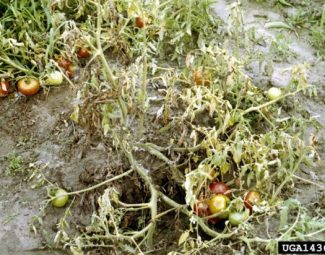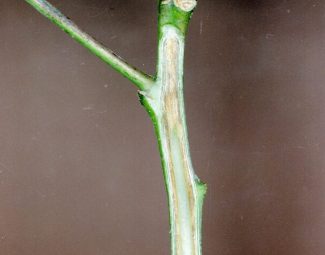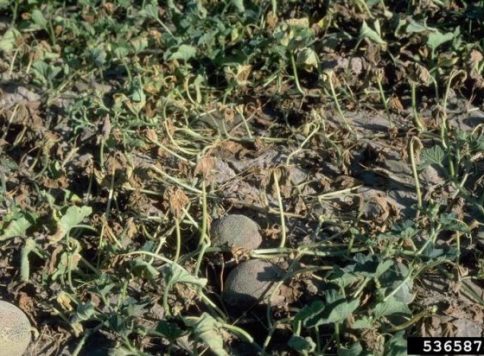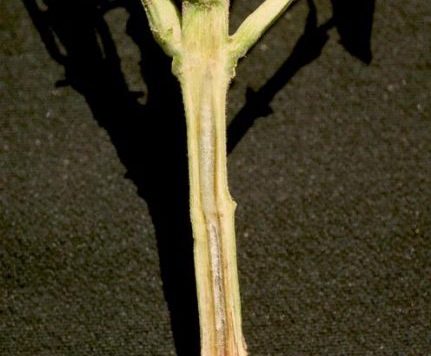Fusarium Wilt
Disease Summary Report
Fusarium oxysporum
General Information
- Fusarium Wilt is similar symptomatically to verticillium wilt.
- Early signs include wilting in the heat of the day and yellowing of lower, older leaves.
- Thickening and widening of the stem at ground level can be indicative, though this can be confused with herbicide damage, esp in watermelons.
- Single shoots may show signs before rest of plant. Entire plant can eventually yellow, then turn brown and die. Vascular system damage begins to limit water flow in the affected portion of the plant, causing wilting and/or dessication.
- Commonly, symptoms become apparent during the period between blossom and fruit formation as water demand rises.
- Exists in three strains referred to as “races”. Race 1 is the most common and widely distributed.
Disease Cycle
- Soil dwelling spores and/or mycelia infect through the root tips, roots that have been compromised by mechanical or insect damage, and in areas of lateral root formation.
- Mycelia invade xylem tissue and use as a transport to upper regions of plant.
- As mycelia grow and increase in density, they eventually restrict or block xylem flow, which disables plant’s ability to distribute water and minerals. Gives xylem tissue brown appearance when exposed.
- Mycelia eventually reach necrotic areas of host plant and rapidly form spores that act as future soil inoculum.
- Can cause death of individual stem outgrowths before causing entire plant to die.
- Fusarium is also saprophytic, which allows mycelia to exist on dead plant material and organic matter in soil.
- Will also persist as spores in soil for 5-10 years or more.
Over wintering Strategy
Over winter as thick walled spores called chlamydospores. These are produced inside of the roots as the plant begins to die.
Organic Control
- Commonly Used Control Products
- Myco Seed Treat (Seed Treatment)
- Bac Pac (Seed Treatment)
- NRG Activate PMSLA (Biological)
- NRG Activate 2004 (Biological)
- AgriEnergy SP-1 (Biological)
- Actinovate (Biological)
- Terra Clean (Sterilizer)
- Residuce (Crop Residue Digester)
Cultural Control
- Maintain good fertility and mineral balance in plants. Identify macro- and micronutrient deficiencies by performing plant tissue and soil analysis. Adjust for deficiencies with foliar and soil applied applications of appropriate fertilizers.
- Minimize factors that contribute to proliferation of inoculation such as: inoculated irrigation tail water from infected fields, dirty machinery, wind, erosion, transplants and seeds that are infected with fusarium, and mechanical and/or insect root injury.
- Avoid overwatering.
- Rotate fusarium immune crops for 5 years or more.
- Remove symptomatic plants as soon as they are identified.
- Plant cultivars that have been identified as being fusarium resistant.
More Images of Fusarium Wilt
Bibliography
- Images by Clemson University – USDA Cooperative Extension Slide Series, Bugwood.org (symptoms of fusarium wilt and fusarium wilt of cotton)
- Images by Howard F. Schwartz, Colorado State University, Bugwood.org (stem of bean plant, melon plants and field of melons showing fusarium infection)
- http://www.extento.hawaii.edu/kbase/crop/Type/f_oxys.htm (Life cycle, symptoms)
- Jones, J.P., J.B. Jones, and W. Miller. 1982. Fusarium wilt on tomato. Fla. Dept. Agric. & Consumer Serv., Div. of Plant Industry. Plant Pathology Circular No. 237. (Symptoms between blossom and fruit maturation)
- Agrios, G.N. 1988. Plant Pathology, 3rd. ed. Academic Press, Inc.: New York. 803pp (Symptoms of Fusarium wilt, root areas susceptible to initial infection).





